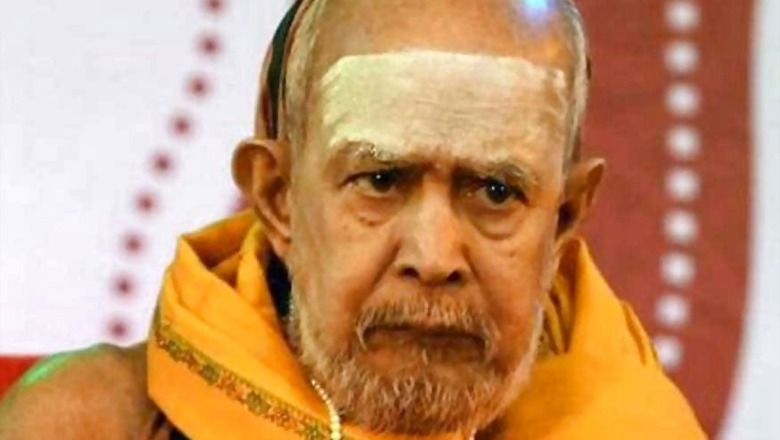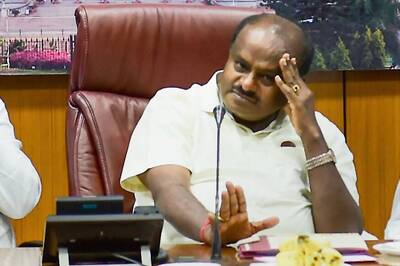
views
Chennai: On the road leading to Kanchi Mutt in Kanchipuram is a board showing the directions. The arrow sign denotes the mutt on the left and Chennai on the right. The two months when Sri Jayendra Saraswati was in prison after his arrest by the Tamil Nadu police in the Sankararaman murder case in 2004, the board was an accurate depiction of the rift between Kanchipuram and Chennai. Jayalalithaa was Chief Minister when the pontiff was arrested and the development was shocking because most people in Chennai thought he advised her on religious-cum-political matters, a raj guru of sorts.
But it would be inaccurate to measure the legacy of the 69th Shankaracharya of the Kanchi Mutt only by the taint of the allegation of the murder. For it was under the stewardship of Jayendra Saraswati that the Kanchi Mutt increased the scope of its philanthropic activities, especially in the areas of education and health. Its footprints were no longer confined only to a Tamil Nadu but pan-south India to a large extent.
The followers of the mutt call Jayendra Saraswati a reformist saint and credit him with ensuring that the preachings of Adi Sankara were spread among people beyond the Brahmin community. This he did by encouraging the spiritual mutt to become more of a social service-oriented one and making it all-inclusive.
But at the same time, it was obvious Jayendra Saraswati did not wish to go down in history merely as a religious figure. He had ambitions of being seen as a seer who understood politics and wanted to have a say in issues facing the nation. It is this approach that led to Jayendra Saraswati playing a part in trying to resolve the Ram Janmabhoomi-Babri Masjid dispute during the NDA rule, by engaging with stakeholders from both communities and the government.
Unlike his predecessors who focused only on matters of religion and spirituality, Jayendra Saraswati in the latter part of his life turned out to be controversy's favourite seer. Whispers emanating from behind the high walls of the mutt suggested a tussle in the mid-80s between Jayendra Saraswati and his predecessor, the venerable Sri Chandrasekharendra Saraswati. When the senior seer appointed 13-year-old Sankaran (subsequently rechristened Vijayendra Saraswati) as the 70th Shankaracharya in 1983, it was reportedly a fallout of his differences with Jayendra Saraswati.
The followers of the mutt were shocked when on the night of August 22, 1987, Jayendra Saraswati abandoned his holy staff and disappeared from the mutt. Vijayendra Saraswati was then formally anointed as the head of the mutt. Jayendra Saraswati who was traced to Talacauvery in Karnataka returned after 17 days and a compromise was reached between the two senior seers. Jayendra Saraswati took charge of the mutt after Chandrasekharendra Saraswati's demise in 1994.
But it was the 2004 murder case of A Sankararaman that undid the image of the seer. The faithful could not come to terms with the fact that the holy man was arrested in a murder case and had to spend two months in jail. The whisper campaign suggested it was the fallout of a business deal that went wrong between the mutt and Jayalalithaa-Sasikala duo. The political reading of his arrest was that Jayalalithaa wanted to send a message to the minorities by arresting the seer on a holy day like Diwali, that she was not entirely pro-Hindu. Just six months ago, Jayalalithaa had suffered a humiliating rout in the Lok Sabha elections, not winning a single seat out of the 39 in Tamil Nadu.
Public Prosecutor K Duraiswamy said in court : “Jayendra Saraswati is the most undeserving criminal deserving no special treatment. We are also devotees of the mutt. We respect the seat but not the individual occupying it.'' These were interpreted as the mind of the political dispensation in Chennai.
The prosecution had based its case on Sankararaman's incriminating letters that pointed to “moral and financial decrepitude” at the mutt. The former mutt functionary had referred to misappropriation of temple funds by the two pontiffs and the influence of their families over matters relating to the mutt. Days after he had written the last letter to a publication, he was found murdered inside a temple in Kanchipuram.
It took nine years for Jayendra Saraswati to come out clean in the murder case. It was a moment of cleansing for the reputation of the mutt as he was the face of the religious institution. But despite his acquittal, his critics continue to point to the influence of the mutt and the political backing by parties like the BJP, as the reason why he got away scot free.
There is no one way of seeing Jayendra Saraswati. In the eyes of his followers, the 82-year-old was a dynamic seer who was felled by baseless allegations that took a toll on Brand Kanchi Mutt. His critics wonder about the future of the ,mutt, that is believed to control assets worth Rs 5000 crore and wonder if the wealth will be safe and used judiciously.
The author is a senior Journalist hailing from hyderabad. The views are personal.




















Comments
0 comment